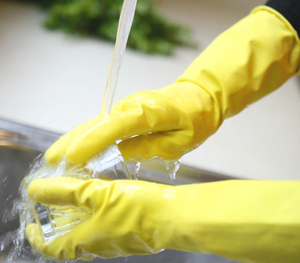

Rubber gloves are best worn with a skin tight fit which, while still allowing for the hands to breathe, makes it easier to hold objects and manipulate them. The palms and fingers usually have a raised pattern which helps provide a good grip when handling objects. Wearing gloves protects the hands from harsh detergents and other cleaning products which are used in the home and elsewhere.Household rubber gloves have been used for washing dishes and cleaning in the home since the 1960s. Many different designs of gloves have been available in a multitude of colors but traditional designs are yellow or pink with long cuffs. While these still remain the most popular patterns today, gloves can be obtained that range from wrist-length to those that are shoulder-length. There are even gloves that are pre-attached to shirts and bodysuits for added protection.
These gloves are traditionally used by people cleaning in the home and are popular with professional cleaners and for clearing up in shops, cafes and other public places. The thickness of the gloves and the long cuffs provide excellent protection for all general cleaning tasks and are useful for all chores where the hands need to be put into water, and provide protection when vacuuming, dusting, and polishing.
The most common material used for making household gloves is latex, a form of rubber. Usually, the gloves have a cotton "flock" lining for easily taking them on and off. However, unlined gloves feel better on the skin and provide a greater ability to manipulate things. They are available in a wider range of colors and cuff lengths. Problems with latex rubber include allergic reactions and poor protection against such substances as solvents. Other materials used to alleviate this are PVC, nitrile, and neoprene. Natural rubber that has been chemically treated to reduce the amount of antibody generators, such as Vytex Natural Rubber Latex, can be used to produce a glove that retains the properties of traditional rubber while exposing the user to significantly reduced amounts of latex allergens.
Gloves are used in the Foodservice Industry for minimizing contact with ready to eat foods. Generally, foodservice employees are required to wash hands before starting work or putting on single-use gloves. Due to the incidence of latex allergies, many people switch to vinyl or nitrile gloves. Poly gloves are a very inexpensive alternative. Latex, Vinyl and Nitrile gloves are available in powder and powder-free varieties. The powder in the gloves are made of USDA cornstarch. Powder-free gloves are generally more expensive than powdered gloves because gloves must be powdered to be removed from the mold they are made on. The majority of disposable gloves are manufactured in China, Malaysia, Indonesia and Vietnam.
Gloves are sometimes used in childcare during the diapering/ toileting process to protect the caregiver from coming in contact with the child's fecal material/urine. Fecal matter in particular as it is known to carry many diseases. Many caregivers use gloves while touching the child's buttocks or genitals when wiping or applying creams.
From Wikipedia
